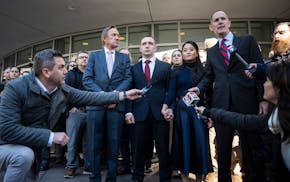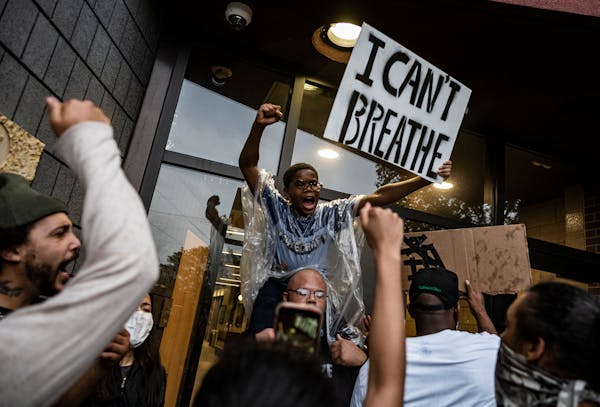Some days, the Minneapolis Police Department's ranks are so thin that just four officers in a given precinct are expected to patrol wide swaths of the city during their shift.
There's often no one available to work the front desk at police stations, so residents seeking assistance with a report are greeted by a locked door. Handmade signs instruct them to dial 911 in an emergency.
Staffing shortages plague law enforcement agencies nationwide, as overall interest in the profession has plummeted amid heightened public scrutiny following a series of high-profile police killings. But the problem is particularly acute in Minneapolis, where the police force continues to hemorrhage officers faster than it can replace them.
Over the past three years, MPD experienced the most significant exodus of uniformed personnel in its history and, last month, dipped to the lowest level in at least four decades.
With 585 sworn officers, the department hovers just above that of the St. Paul police department, an agency that serves roughly 120,000 fewer residents. That decline means Minneapolis holds among the lowest ratio of police officers to population served out of 22 sampled American cities, according to a Star Tribune analysis. Only Portland had a lower officer-to-resident ratio by the end of 2022 with 1.3 officers per 1,000 residents, compared to 1.4 in Minneapolis. That's significantly lower than the national average of 2.4.
Rapid attrition resulted in ballooning overtime costs, longer response times and a precipitous drop in proactive policing. Every day requires a form of triage, as top brass examine citywide staffing levels to determine whether to reassign officers to a neighboring precinct that's running short.
"This is absolutely not sustainable," Chief Brian O'Hara said of continuing to operate without additional manpower. "Thank God for all these other agencies that are filling this gap."
He credited law enforcement partners, like the Bureau of Criminal Apprehension and Hennepin County Sheriff's Office, for helping drive down violent crime this summer following three of the bloodiest years in the city's history.
In recent months, the department has also leaned on temporary civilian analysts to mine video and assist with clerical work on pending criminal investigations. But MPD is unable to spare officers to restart the disbanded community engagement unit, long seen as a critical tool in building trust.
"It's unfortunate, but that's the stuff that goes away first," O'Hara said. "We're never going to change people's perception of us — and we're never going to establish meaningful relationships with people — if the only thing we're doing is responding from emergency to emergency to emergency."
Unprecedented departures
A decades-old city charter sets a minimum requirement for staffing based on population levels, equivalent to about 723 officers.
For years, Minneapolis employed far more than what was obligated, logging around 900 at the time of George Floyd's murder. But MPD experienced an unprecedented wave of resignations, retirements and disability claims, mostly related to post-traumatic stress disorder, in the months that followed.
The issue of police staffing became a political lightning rod almost overnight — as homicides surged to the worst in a generation — sparking intense public debate about how best to transform public safety amidst a global racial reckoning. In 2021, voters rejected a proposal that would have eliminated that quota and allowed officials to replace MPD with a new agency.
"We gotta be able to call somebody — and the way the system stands right now, that's the police," said Audua Pugh, one of eight North Side residents who sued the city in 2020 demanding they hire more officers. At the time, gunfire was so common in her Jordan neighborhood that she contemplated moving.
Police reform advocates saw that ballot measure as a chance to shift its reliance from a militarized police response toward alternative approaches for certain 911 calls, like mental health crises. Some question whether MPD needs to maintain peak staffing levels when pilot programs like Minneapolis' Behavioral Crisis Response (BCR) teams are successfully diverting thousands of calls traditionally handled by police.
"There are functions for which you simply don't need sworn, armed officers," said Dave Bicking, vice president of Communities United Against Police Brutality. He called the 1960s-era charter minimum "a historical artifact," which failed to take into account modern technology that make officers more efficient.
Crime rates are driven by a multitude of social and economic factors that cannot be predicted by the size of a police force alone, said Michelle Phelps, a sociology professor at the University of Minnesota who studies policing. Research shows that bolstering department ranks can bring modest reductions in homicide rates, but also result in a surge of lower-level arrests that disproportionately impact people of color.
"Even in the best-case scenario, ... [hiring more officers] is obviously not a panacea," Phelps said. "I think our police department is going to have to figure out how to operate at a smaller scale."
Last summer, the Minnesota Supreme Court ruled that City Council members had fulfilled their responsibilities to the Charter by funding the authorized 731 officers in the annual budget, but said Mayor Jacob Frey must ensure that the minimum number of positions were filled.
Despite lofty goals to hire some 200 officers, recruiting efforts haven't kept pace with the wave of retirements. Each month, the police force continues to dwindle and the city remains in violation of the court order.
"It's a self-induced problem," said Doug Seaton, president of the Upper Midwest Law Center, which represented the group that sued. "They've created the mess that has resulted in some of the reticence to join up, or apply for, those police positions."
Minneapolis has not done enough to entice new recruits through signing bonuses or other means, Seaton said. His clients are prepared to intervene again should the city fail to meet its legal obligations long-term.
Waning interest in policing
Police applications and overall interest in law enforcement has been waning for years, though experts say that Floyd's murder marked a turning point for the profession.
A 2021 study of nearly 200 U.S. law enforcement agencies found that the rate of retirements at some departments rose 45% compared with the previous year, a dramatic increase that the report's authors blamed on mass protests and calls for defunding the police, as well as the pandemic.
"The risks associated with the job have never been higher," said Chuck Wexler, executive director of the Police Executive Research Forum in Washington, D.C.
Every police department in the country is competing for the same ever-shrinking pool of candidates. Some, like Alameda, Calif. are offering $75,000 signing bonuses to help fill critical vacancies. In Minnesota, even small suburban agencies are dangling $2,000 to $10,000 to incentivize lateral transfers and new recruits.
Fierce competition has forced officials to get creative. This year, an MPD recruitment team went door-knocking in diverse North and South side neighborhoods to try and drum up interest. But replenishing the ranks is a tall order. City records show that the department has lost 45 sworn officers so far in 2023, and hired just 15 to replace them. (Eleven more are expected to graduate from the academy later this month.)
"The aura of working for a larger city with vastly more opportunities than neighboring suburban departments is no longer enough when weighed against the political nonsense within Minneapolis, coupled with low pay and two consent decrees," said Minneapolis Police Federation President Sherral Schmidt. "In order to add to our ranks, the city needs to offer competitive wages and benefits."
Staffing has emerged as the highest priority for the police union amid ongoing contract negotiations with the city this fall. Of the 585 officers, at least 30 remain on continuous leave. An estimated 284 are currently able to answer 911 calls, Schmidt said.
As of Sept. 1, the department had already racked up a record-high $14.3 million in overtime costs — more than half of which was paid under "critical staffing overtime," better known as double time.
Overtime helped most MPD employees make more than six figures last year, according to payroll data obtained through a public records request. Two sergeants managed to pull in over $350,000 during that time, well surpassing O'Hara's annual salary of $271,721.
The police budget has continued to climb even as the department atrophied. Frey's proposed 2024 budget allocates $218 million to MPD, a record-setting sum meant to fund dozens of new positions tasked with carrying out court-mandated police reforms.
Escalating overtime hours are fueling concerns about burnout and the potential for officer error. In an interview, Frey agreed that the current situation is untenable and the city must rebuild staffing so officers have the ability "to recalibrate" between shifts.
"It's a fact: Use of force goes up for every hour of overtime," he said. "That's not because they're bad people; it's because they are people."
The department must constantly balance shortages, as officers call in sick, take vacation time or fulfill mandatory training requirements. They do so by holding over earlier shifts, tapping response cars from neighboring precincts and putting out citywide bids for overtime to backfill positions.
Yet, the department is frequently unable to meet minimum staffing goals for each shift, which often results in the decision to leave front desks vacant at local precincts.
Those closures frustrate residents, who say it's difficult to rebuild trust with a department that isn't available to interact with the citizens they serve.
"It tells me that the people of Minneapolis are not a priority to the Minneapolis police department," said Colin Planalp, a public health researcher who drove to three separate precincts to turn in a lost wallet and keys earlier this spring. He found each one locked.
In response to complaints about locked precincts, O'Hara countered: "I think it's worth more to have that person on the street."
Staff writer Andy Mannix contributed to this report.
Jogger on rural southwestern Minnesota road is hit from behind by pickup and killed

Hundreds of supporters rally at courthouse as Minnesota State trooper appears for murder hearing
Rollover wreck of vehicle exiting I-94 in Minneapolis leaves 1 woman dead, 4 injured

Perfection comes with a reward for 3 teams in baseball Metro Top 10

